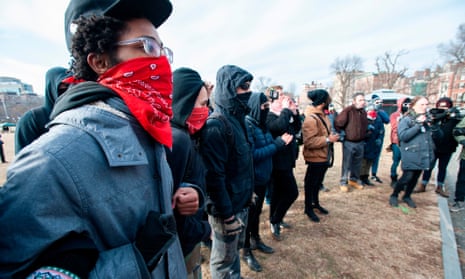Donald Trump promised on Twitter this week that “the United States of America will be designating ANTIFA as a Terrorist Organization”.
Legal experts immediately threw cold water on the proposal, arguing that there may be no means by which any domestic entity can be designated in this way.
But, perhaps more importantly, experts also say that there is no actual antifa organization for Trump to define in this way. Put simply: antifa does not really exist as a distinct entity.
Then what is antifa?
Antifa is a useful umbrella term that denotes a broad spectrum of groups and individuals of far-left or anarchist tendencies. The term itself means simply anti-fascist.
Mark Bray, a historian and the author of Antifa: The Antifascist Handbook, said in a telephone conversation that antifa is a loose movement of “decentralized revolutionary self defense” opposed to the far right.
But some people believe in it?
Antifa conspiracy theories are common amongst rightwing politicians, media and activists. Bray said: “The right describes antifa as a unitary organization with leaders and even secret funding” though that is simply not true.
An antisemitic conspiracy theory that the billionaire financier George Soros funds antifa also has widespread currency on the right, including among influential Trump-world figures.
Although the president and his allies wish to conflate large protests in every city with radical anti-fascist groups, Bray says they “drastically overstate the numbers and influence” of committed Antifa activists.
But there is a history here?
The antifa movement traces its heritage to radical left groups that resisted dictators such as Mussolini and Hitler in Europe in the 1930s. In Germany, the communist-aligned Antifaschistische Aktion fought street battles with Hitler’s followers until it was forcibly disbanded in 1933.
This tradition was revived in Europe during the 1980s and 1990s, with the rise of nazi skinheads and other far right groups. It arrived in the US in the late 1980s, with the creation of Anti Racist Action (ARA) in Minneapolis.
So who are some antifa groups?
The movement – which is also strongly associated with anarchist politics – is not defined by lasting institutions. ARA no longer exists and the oldest identifiable group in the US is probably Portland’s Rose City Antifa, which dates from 2007.
Contemporary antifa groups have a distinctive repertoire of tactics ranging from publicly identifying members of far-right groups, to physically resisting them in the streets. Often, in street protests, activists dress in “black bloc” attire including balaclavas or masks to conceal their identity.
Is antifa violent?
Sometimes, antifa street demonstrations involve violence: between activists and police, or members of far-right groups, or both.
The most controversial recent episodes have involved violent confrontations with rightwing social media personalities and sometimes, with journalists and photographers who activists believe will compromise their anonymity.
Bray says that antifa’s actions in this respect “are nothing like the violence police have visited on journalists” in recent days as dozens of reporters have been beaten, teargassed, shot and arrested by police covering the Black Lives Matter protests.
